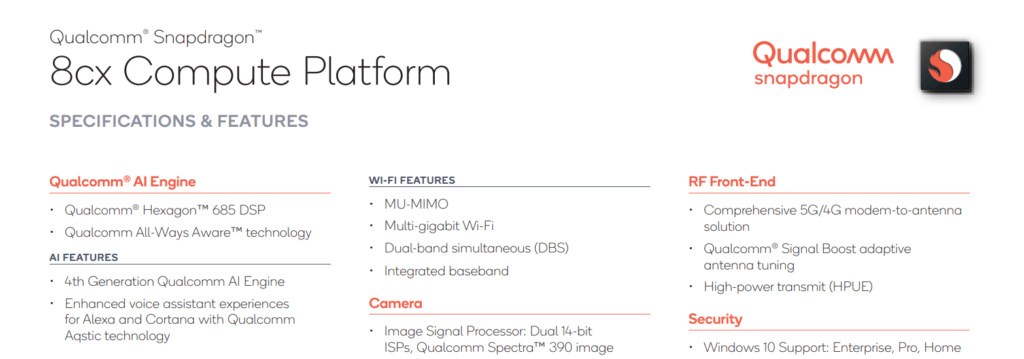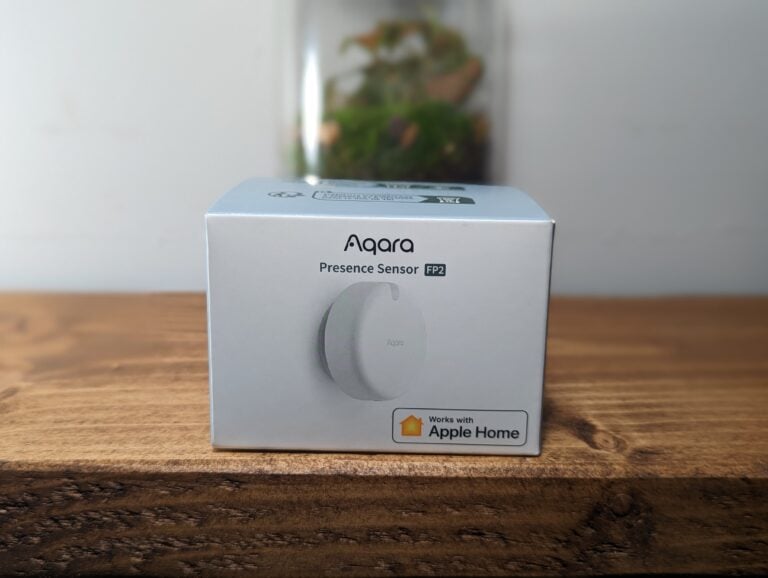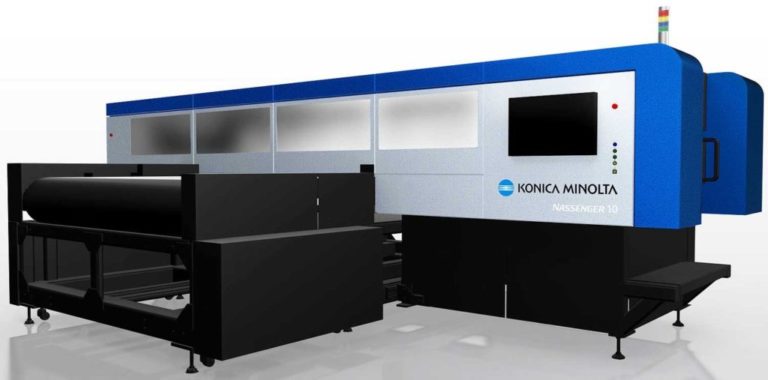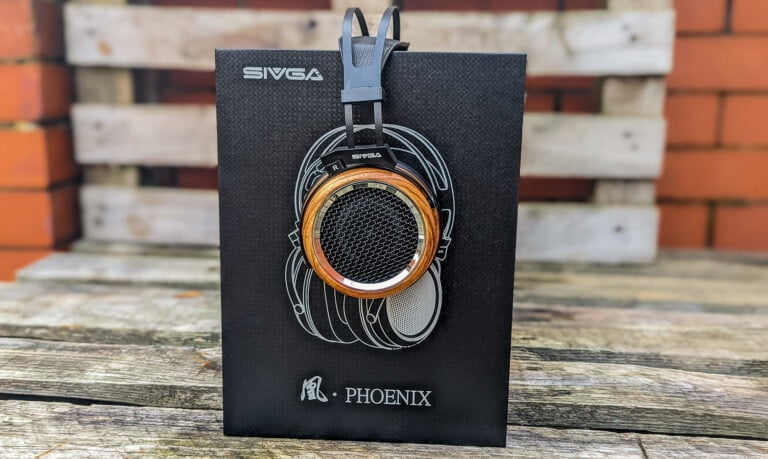Any links to online stores should be assumed to be affiliates. The company or PR agency provides all or most review samples. They have no control over my content, and I provide my honest opinion.
Qualcomm introduced the Snapdragon 8cx at last years tech summit, rather than upgrade that chipset, this year they have padded out the portfolio with two new more affordable options with the Snapdragon 8C and the 7C.
The Microsoft Surface Pro X features the modified 8cx called the Microsoft SQ1 Processor and this currently costs £1,269.00 so these new chipsets should allow manufacturers to get well under the £1000 (I hope).
So how do the new chipsets compare against the flagship Snapdragon 8cx?
Snapdragon 8c and Snapdragon 850
It would seem that the Snapdragon 8c is being positioned as the direct successor to the Snapdragon 850 with the 8cx being a more premium chipset. This then leaves the 7c being for the more affordable segment.
When Qualcomm references performance improvements, it seems to be in relation to the Snapdragon 850.

CPU
Unlike the range of mobile chipsets such as the Snapdragon 865, Qualcomm are a little shy about revealing the exact specification of their Windows on Arm chipsets.
With the Snapdragon 8cx it is an octa-core CPU manufactured on the 7nm fabrication process featuring eight Kryo 495 cores. This is then a big little layout with four ARM Cortex-A76 (Gold) cores clocked at 2.84 GHz and four ARM Cortex-A55 (Silver) cores clocked at 1.9 GHz under load. The Microsoft SQ1 Processor went up to 3Ghz.
With the two new chipsets, we are left guessing for the majority of them.
The Snapdragon 8c is fabricated on the 7nm process and features eight Kryo 490 cores going up to 2.45 GHz. There is no word on how this is broken down but you can assume the small cores will be ARM Cortex-A55. With this sharing the 49x Kryo name I would assume the larger cores are ARM Cortex-A76 but clocked at 2.45 GHz vs 2.84Ghz. Qualcomm claims this delivers 30% faster total system performance over the previous platform
The Snapdragon 7c then has eight cores using the Kryo 468 CPU up to 2.4 GHz. Again I would assume the little cores are A55 but there is not much difference with the clocks to the 8C and the Kryo 468 name suggests this won’t be a Coretex A76. The older Snapdragon 850 which features the Kryo 385 used Cortex-A75. For this one Qualcomm state up to 20% faster system performance and up 2x the battery life of typical entry-level PCs, so who knows what they mean exactly by this.
GPU
The Qualcomm Snapdragon 8cx uses the Adreno 680 which is a supped up version of the Adreno 640 in the Snapdragon 855.
The Snapdragon 8c uses the Adreno 675 which delivers up to a 40% performance improvement over the previous SD850.
Then the Snapdragon 7c has the Adreno 618 and they make no performance claims here other than you can enjoy a little light gaming, or you can stream the latest videos at up to 4K HDR resolutions. So I would keep your expectations low here.
Memory and Storage
Memory and storage difference a little more clear. For memory, they all use LPDDR4x up to 2133 MHz. The 8xc has 8 channels up to 16GB, the 8C has 4 and the 7C has 2.
For storage, both the 8cx and 8c have access to NVMe SSD and UFS 3.0, while the 7c has eMMC 5.1 and UFS 3.0.
Imaging / Video
The Snapdragon 8cx has a dual 14-bit ISP using the Qualcomm Spectra 390 image signal processor
The Snapdragon 8c also has a dual 14-bit ISP using the Qualcomm Spectra 390 image signal processor.
The Snapdragon 7c has a single 14bit ISP with the Spectra 255.
They all do 4K HDR video capture @ 30 FPS, slow-mo at 720p and 480fps, and can have dual 16MP lenses at 30FPS with Zero Shutter Lag or a single HFR 32MP camera @ 30FPS with ZSL.
And they both have codec support for H.265 (HEVC), H.264 (AVC), VP9
Only the 7c has playback details which states:
- 4K 30fps video playback with HDR support
- H.264 (AVC), H.265 (HEVC) VP8 and VP9 format support for playback
- 4K 30fps video capture • H.264 (AVC), H.265 (HEVC) format support for capture
You can assume the same for the 8cx and 8c.
AI
Just to make things confusing Qualcomm seems to have switched around the way they name things here.
The 7c has the Hexagon 692 DSP capable of 5 TOPS
Then the 8c has the Hexagon 690 capable of 6 TOPS

And the 8cx has the Hexagon 685.
To confuse matters further, the 8cx is mainly based on the SD855 but the Hexagon 685 was used on the Snapdragon 845. Qualcomm didn’t state how many tera operations per second the 8cx does.
Modem and Wi-Fi
Both the Snapdragon 8cx and 8c feature the Snapdragon X24 LTE modem capable of 2 Gbps down. Both of these can have the optional X55 modem providing 5G.
The Snapdragon 7c has the Snapdragon X15 LTE which is capable of 800 Mbps down. The product brief makes no mention of the X55 so it probably can’t have it.
None of the laptops has Wi-Fi 6 (11ax) built-in, but they are all Wi-Fi 6 (11ax) ready from what I can tell. At least, it is only the 7c that mentions this, so it’s probably true with the others. So it is up to the OEM if they integrate it.
The 8c and 8cx have 802.11ad, 802.11ac Wave 2 etc. but the 7c just states 2×2 MIMO 2.4Ghz and 5Ghz. It is possible the 7c does not have 802.11ad, which is reasonably rare anyway.
Qualcomm Snapdragon 8c vs Snapdragon 7c vs Snapdragon 8cx Specification Table
| Qualcomm Snapdragon 8c | Qualcomm Snapdragon 7c | Qualcomm Snapdragon 8cx | |
|---|---|---|---|
| Fabrication Process | 7 nm | 8 nm | 7 nm |
| CPU | Octa-core Kryo 490 CPU Up to 2.45 GHz | octa-core Kryo 468 CPU Up to 2.4 GHz | Octa-core Kryo 495 CPU up to 3GHz |
| 4 x ARM Cortex-A76? | 4 x ARM Cortex-? | 4 x ARM Cortex-A76 @2.84 GHz | |
| 4 x ARM Cortex-A55 | 4 x ARM Cortex-A55 | 4 x ARM Cortex-A55 @ 1.9 GHz | |
| GPU | Adreno 675 | Adreno 618 GPU | Adreno 680 |
| Memory | 4xLPDDR4x @ 2133 MHz | 2xLPDDR4 @ 2133 MHz | 8xLPDDR4x upto 16 GB |
| Storage | NVMe SSD; UFS 3.0 | eMMC 5.1; UFS 3.0 | NVME SSD; UFS3.0 |
| Imaging | Dual 14-bit ISPs, Qualcomm Spectra 390 | 14-bit ISPs / Qualcomm Spectra 255 | Dual 14-bit ISPs, Qualcomm Spectra™ 390 |
| AI | Hexagon 690 / 6 TOPS | Hexagon™ 692 / 5 TOPS | Hexagon 685 DSP |
| Modem | Integrated Snapdragon X24 LTE | Integrated Snapdragon X15 LTE | Integrated Snapdragon X24 LTE |
| Up to 2 Gbps | up to 800 Mbps LTE | Up to 2 Gbps | |
| Optional 5G X55 | Optional 5G X55 | ||
| Wi-Fi | 802.11ad, 802.11ac Wave 2, 802.11a/b/g, 802.11n | 802.11ad, 802.11ac Wave 2, 802.11a/b/g, 802.11n | 802.11ad, 802.11ac Wave 2, 802.11a/b/g, 802.11n |
| Wi-Fi 6 (11ax) ready | Wi-Fi 6 (11ax) ready | Wi-Fi 6 (11ax) ready |
I am James, a UK-based tech enthusiast and the Editor and Owner of Mighty Gadget, which I’ve proudly run since 2007. Passionate about all things technology, my expertise spans from computers and networking to mobile, wearables, and smart home devices.
As a fitness fanatic who loves running and cycling, I also have a keen interest in fitness-related technology, and I take every opportunity to cover this niche on my blog. My diverse interests allow me to bring a unique perspective to tech blogging, merging lifestyle, fitness, and the latest tech trends.
In my academic pursuits, I earned a BSc in Information Systems Design from UCLAN, before advancing my learning with a Master’s Degree in Computing. This advanced study also included Cisco CCNA accreditation, further demonstrating my commitment to understanding and staying ahead of the technology curve.
I’m proud to share that Vuelio has consistently ranked Mighty Gadget as one of the top technology blogs in the UK. With my dedication to technology and drive to share my insights, I aim to continue providing my readers with engaging and informative content.






